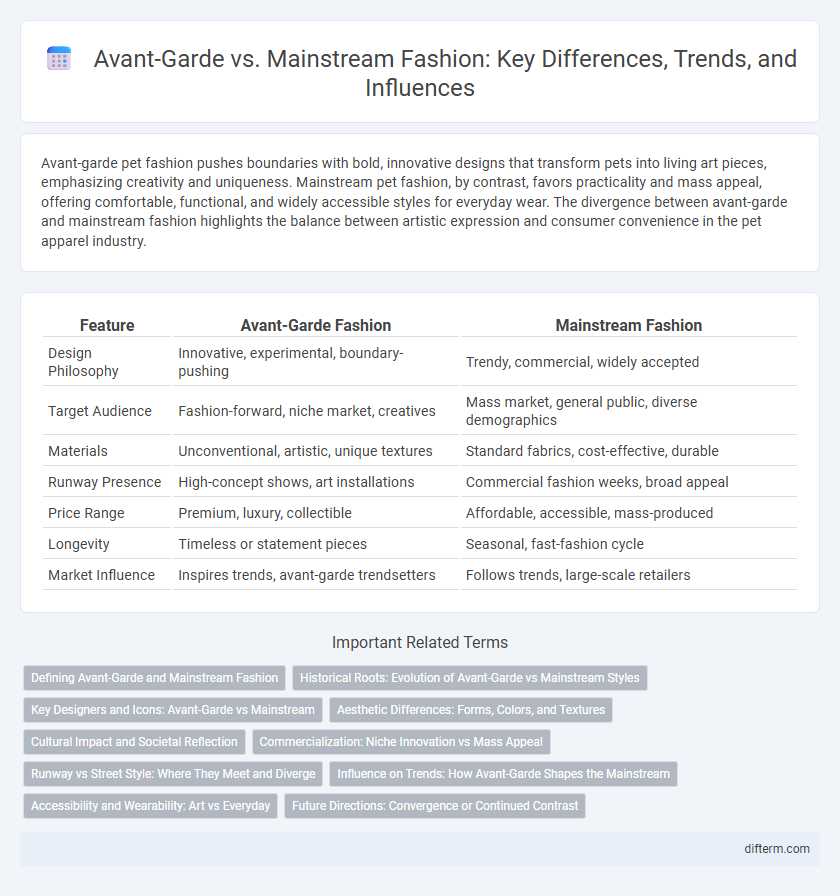Avant-garde pet fashion pushes boundaries with bold, innovative designs that transform pets into living art pieces, emphasizing creativity and uniqueness. Mainstream pet fashion, by contrast, favors practicality and mass appeal, offering comfortable, functional, and widely accessible styles for everyday wear. The divergence between avant-garde and mainstream fashion highlights the balance between artistic expression and consumer convenience in the pet apparel industry.
Table of Comparison
| Feature | Avant-Garde Fashion | Mainstream Fashion |
|---|---|---|
| Design Philosophy | Innovative, experimental, boundary-pushing | Trendy, commercial, widely accepted |
| Target Audience | Fashion-forward, niche market, creatives | Mass market, general public, diverse demographics |
| Materials | Unconventional, artistic, unique textures | Standard fabrics, cost-effective, durable |
| Runway Presence | High-concept shows, art installations | Commercial fashion weeks, broad appeal |
| Price Range | Premium, luxury, collectible | Affordable, accessible, mass-produced |
| Longevity | Timeless or statement pieces | Seasonal, fast-fashion cycle |
| Market Influence | Inspires trends, avant-garde trendsetters | Follows trends, large-scale retailers |
Defining Avant-Garde and Mainstream Fashion
Avant-garde fashion challenges conventional styles through experimental designs, innovative materials, and bold silhouettes that prioritize artistic expression over commercial appeal. Mainstream fashion emphasizes widely accepted trends, practicality, and mass-market accessibility, often driven by popular culture and retail demand. The contrast between avant-garde and mainstream fashion lies in their core objectives: avant-garde pushes boundaries of creativity, while mainstream seeks broad consumer approval and wearability.
Historical Roots: Evolution of Avant-Garde vs Mainstream Styles
Avant-garde fashion emerged in the early 20th century as a radical break from traditional styles, driven by designers like Elsa Schiaparelli and Rei Kawakubo who emphasized innovation and artistic expression. Mainstream fashion evolved more conservatively, influenced by mass production and commercial appeal, reflecting broader cultural trends and consumer preferences. The historical evolution highlights avant-garde's role in challenging fashion norms while mainstream styles prioritize accessibility and wearability.
Key Designers and Icons: Avant-Garde vs Mainstream
Avant-garde fashion pioneers like Rei Kawakubo and Alexander McQueen challenge conventional aesthetics with experimental silhouettes and unconventional materials, pushing the boundaries of creativity. In contrast, mainstream designers such as Michael Kors and Ralph Lauren emphasize wearability, timeless elegance, and commercial appeal, appealing to a broad consumer base. Iconic figures like Lady Gaga and Rihanna often bridge these worlds by incorporating avant-garde elements into mainstream fashion, influencing trends and expanding the industry's creative horizons.
Aesthetic Differences: Forms, Colors, and Textures
Avant-garde fashion challenges traditional aesthetics with unconventional forms, bold color palettes, and experimental textures that push the boundaries of design. Mainstream fashion favors familiar silhouettes, harmonious color schemes, and smooth, comfortable fabrics that appeal to mass-market preferences. The contrast between avant-garde's artistic innovation and mainstream's commercial appeal highlights distinct approaches to visual and tactile expression in contemporary style.
Cultural Impact and Societal Reflection
Avant-garde fashion challenges conventional norms by pushing creative boundaries, often reflecting subversive cultural movements and inspiring societal dialogue on identity and futurism. Mainstream fashion, shaped by mass consumption and popular trends, mirrors prevailing social values and collective aspirations, reinforcing cultural cohesion. The interplay between avant-garde innovation and mainstream acceptance drives the evolution of fashion as a dynamic cultural and social catalyst.
Commercialization: Niche Innovation vs Mass Appeal
Avant-garde fashion thrives on niche innovation, pushing boundaries with experimental designs that challenge traditional aesthetics but often lack broad market appeal. Mainstream fashion prioritizes mass appeal, focusing on commercial viability through accessible styles and scalable production. This commercialization process transforms avant-garde concepts into consumer-friendly trends, blending creativity with profitability.
Runway vs Street Style: Where They Meet and Diverge
Runway fashion showcases avant-garde designs emphasizing experimental silhouettes, bold colors, and conceptual artistry that push the boundaries of creativity. Street style, representing mainstream fashion, blends practicality with current trends, reflecting everyday individuality and cultural diversity through wearable, accessible pieces. Both realms intersect when runway innovations inspire streetwear adaptations, yet they diverge as runway remains a platform for high-concept expression while street style prioritizes comfort and real-world functionality.
Influence on Trends: How Avant-Garde Shapes the Mainstream
Avant-garde fashion pioneers unconventional designs and experimental aesthetics that challenge traditional norms, inspiring mainstream brands to adopt innovative elements over time. By pushing boundaries in materials, silhouettes, and concepts, avant-garde designers act as catalysts for new trends that eventually permeate mass-market fashion. This influence accelerates the evolution of style, ensuring the mainstream continuously reinvents itself through bold, forward-thinking creativity.
Accessibility and Wearability: Art vs Everyday
Avant-garde fashion challenges conventional norms with bold, experimental designs that prioritize artistic expression over everyday practicality, often limiting accessibility due to high costs and unconventional materials. Mainstream fashion emphasizes wearability and mass appeal, utilizing affordable fabrics and adaptable styles to suit diverse lifestyles and scale production efficiently. The balance between avant-garde art and mainstream accessibility defines the dynamic spectrum of fashion innovation and consumer inclusion.
Future Directions: Convergence or Continued Contrast
Avant-garde fashion pushes boundaries with experimental designs and unconventional materials, challenging traditional aesthetics and influencing future trends. Mainstream fashion prioritizes accessibility and commercial viability, often adapting avant-garde elements in a toned-down form to appeal to a wider audience. Future directions may see a convergence where innovative concepts gradually permeate everyday wear, or a continued contrast preserving avant-garde's role as a distinct creative force separate from mass-market appeal.
avant-garde vs mainstream Infographic

 difterm.com
difterm.com